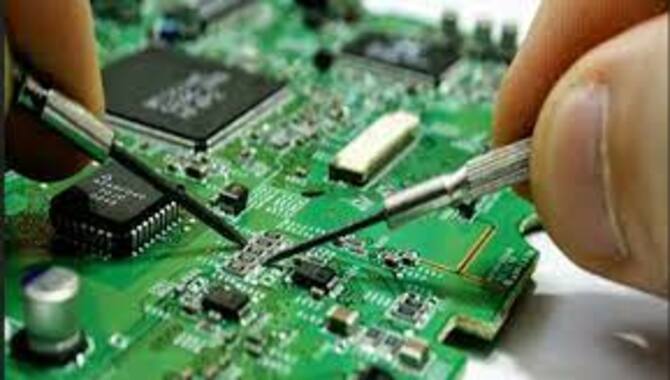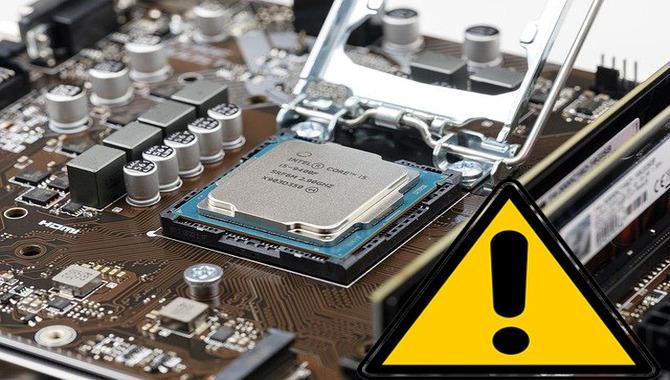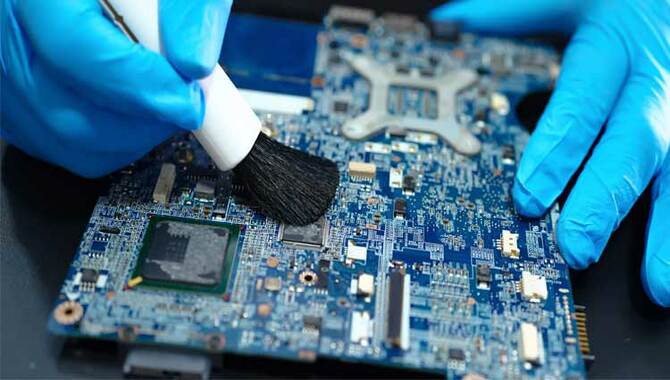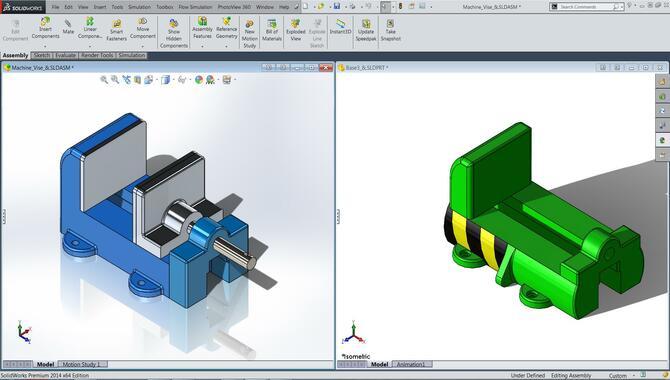Laptop chip-level repair is a process that is usually needed when the laptop’s motherboard starts to fail. This repair is required because it’s impossible to replace the motherboard without repairing the chip level.
If you’re experiencing issues with your laptop and you’re unable to repair the chip level repair, don’t worry – we’ve got you covered.
In this blog, we’ll guide you through the 7 easy steps necessary to fix your laptop chip level repair. Make sure to read through each step carefully, as any mistake during this process can result in a worse situation. We hope this guide will help you get your laptop back up and running as soon as possible.

What To Do If Your Laptop Chip Won’t Work
If your laptop chip (or other components) won’t work, there are a few things you can do to try and fix the problem. The first step is to try resetting the computer by pressing and holding down the power button for about 20 seconds.
If that doesn’t work, remove debris or dust around the chip area with a vacuum cleaner or cloth. If that still doesn’t work, it might be time to take your laptop in for repair. In the meantime, you can try some of the other solutions listed below.
7 Easy Steps To Laptop Chip Level Repair

As technology and computing evolve, so does how we use our laptops. In recent years, laptop chips have become a major issue, as static electricity can easily damage them. This can cause problems with the laptop’s memory, storage, and overall performance. It is important to keep your laptop chip level regularly repaired to avoid these issues.
Laptop chip-level repair kits are available online and in most electronics stores and are relatively easy to use. All you need is some basic tools (like a Phillips screwdriver) and access to a power source (like an outlet). Here are 7 Easy steps to laptop chip level repair:
1.Check If The CPU Is Damaged

If you’re looking to troubleshoot a CPU issue on your laptop, it’s important to first check the level of the chip. This guide will help you get started with that. After checking the level of the chip, you’ll need to gather some tools and materials before starting repair work. Prepare for potential setbacks. If things go wrong, don’t be afraid to take your laptop to a tech support center. Overall, this repair is not too difficult but does require some effort and patience.
2.Remove The Battery

When your laptop starts to act weird, the first thing you should do is remove the battery. This will help rule out any hardware issues and save you time and hassle in figuring out what’s wrong. If your laptop won’t turn on at all, then it’s most likely that the battery fries – take it to a service center for repairs.
Suppose you’re only getting errors when starting or opening programs. In that case, it might be something as simple as a corrupted file or registry entry – try restoring your system to its previous state using software like System Mechanic.
3.Clean The Laptop Motherboard And Contacts

The laptop motherboard and contacts can often become dirty, which can impede the laptop’s performance. First, remove any dust, lint, or other debris using a can of compressed air to clean them properly. Then use a dry cloth to wipe down the entire laptop and apply a thin layer of thermal paste if needed. Finally, replace your battery if it needs doing and reconnect the power cord. Turn on your laptop – it should now start up normally.
4.Clean The Area Around The Chip With Rubbing Alcohol

If your laptop’s screen shows signs of corruption or damage, it’s probably time to take it in for repair. To do this in a safe and effective way, you’ll need to clean the area around the chip before doing anything else.
To clean the area around the chip, use rubbing alcohol. Make a small hole in the plastic bag you’re using as a mask and pour some alcohol into it. Rubbing alcohol effectively removes dirt, dust, and other debris from surfaces. So, once you’ve cleaned the chip area with alcohol, replace the plastic bag and seal it shut using tape.
5.Test For Continuity On The Main Power Supply Cable

Before starting, make sure that your laptop turns off and unplugged. Next, open the laptop’s battery cover. The power supply cable should be easily visible near the battery. If it’s not, look for it near the motherboard. Once you’ve located it, take note of its location and orientation. If there is a power outage, it’s important to ensure that the main power supply cable is properly repaired. This can do by following these easy steps:
- Use a voltmeter to measure the voltage at the main power supply cable connector.
- If it is low or absent, then the cable needs to replace, and continuity checked again before continuing with repair work.
- The steps are simple and take just a few minutes – perfect if you’re in a hurry.
6.Replace Any Failed Components

If your laptop starts to experience problems, the first thing you should do is replace any failed components. This will help get your laptop back up and running quickly.
To identify which parts need to replace, you’ll need to take your laptop to a qualified service provider. They will be able to test it for broken components and advise you on the best course of action.
The most common parts that fail in laptops are the motherboard, processor, graphics card, memory, and storage drives. If any of these parts fails, it can cause major problems with your computer. It’s important to replace them as soon as possible in order to avoid prolonged downtime and frustrating errors.
7.Reattach Cables And Check Functionality

If your laptop has a damaged or faulty chip, you’ll need to take it in for repair. To start, remove the battery by pressing the small button on the side and slide it out. Unplug the power cable from the back of the laptop and remove the screws that hold the casing together. Carefully pry up each corner of the casing and then pull it off completely. Be sure to save all of the screws.
Once the casing is off, you’ll be able to see all of the internal parts. Check to ensure that all your cables attach properly – if they’re not, reconnect them using the correct connector type and tighten them using a Phillips screwdriver. Finally, reattach any screws you removed and test your laptop for functionality.
Conclusion
A laptop chip-level repair guide can provide the information you need to fix your laptop or computer if it starts experiencing problems. By understanding the different types of laptop chips and their locations, you can determine which one is causing the issue and how to fix it.
If your laptop chip-level repair doesn’t seem to be working, these easy steps you can take to get it up and to run again. Follow these 7 easy steps laptop chip level repair guide, and you should be ready. If you need further assistance, don’t hesitate to contact us on our social media platforms or via our contact form. We would be happy to help.
Frequently Asked Questions
1.What Is Chip-Level Laptop Repairing?
Ans: A laptop motherboard contains many components, including the chip level. If this part fails, it can cause problems with your laptop, like freezing or black screens. So to fix such issues, you will need to replace the entire motherboard. This process usually takes around 2 hours and costs between $250-$500.
2.How Can I Learn Laptop Repair?
Ans: If your laptop is not starting or running smoothly, it may be time for a chip-level repair. To fix the issue, you’ll need to replace the defective chip with a new one. You can do this or take your laptop to a local technician for repairs. Keep track of when the chip was installed so you can revert if needed.
3.What Is Meant By Chip-Level Service?
Ans: A Chip level service is exactly what it sounds like – a technician will replace the faulty chip in your laptop with a new one, restoring it to its original condition. This can be beneficial when your laptop’s battery is running low, and the chip is malfunctioning.
4.How Can I Determine If My Laptop Needs A Chip-Level Repair?
Ans: Whenever you start experiencing problems with your laptop, one of the first things to do is to check if there’s a problem with its chip level. This is usually indicated by errors or system crashes. If so, it may be necessary to replace your laptop’s chip.
Chip-level repairs can do at relatively low costs and don’t typically require sending your machine in for repairs.
5.What Should I Do If My Laptop Doesn’t Boot Properly After Repairing It?
Ans: If your laptop doesn’t boot properly or starts failing to start up, it may be due to a defective chip level repair. You can fix this in most cases by replacing the chip level repair and the motherboard. The process shouldn’t take more than 2 hours and will cost you around $200.

Leave a Reply